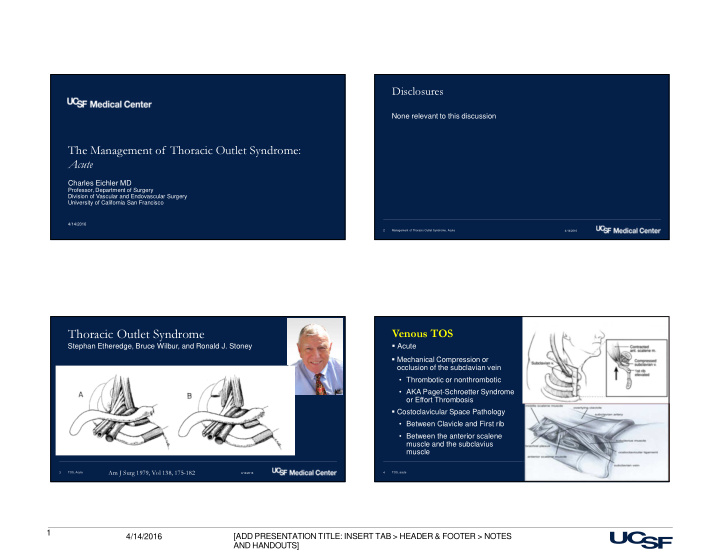



Disclosures None relevant to this discussion The Management of Thoracic Outlet Syndrome: Acute Charles Eichler MD Professor, Department of Surgery Division of Vascular and Endovascular Surgery University of California San Francisco 4/14/2016 2 Management of Thoracic Outlet Syndrome, Acute 4/14/2016 Venous TOS Thoracic Outlet Syndrome Stephan Etheredge, Bruce Wilbur, and Ronald J. Stoney � Acute � Mechanical Compression or occlusion of the subclavian vein • Thrombotic or nonthrombotic • AKA Paget-Schroetter Syndrome or Effort Thrombosis � Costoclavicular Space Pathology • Between Clavicle and First rib • Between the anterior scalene muscle and the subclavius muscle 3 TOS, Acute 4/14/2016 4 TOS, acute 4/14/2016 Am J Surg 1979, Vol 138, 175-182 1 4/14/2016 [ADD PRESENTATION TITLE: INSERT TAB > HEADER & FOOTER > NOTES AND HANDOUTS]
Thrombotic (Most common) Non occlusive: • Intermittent, positional, arm discoloration, swelling and aching • Elicited by exercise or arm elevation • Sudden onset • Aching, swelling, heaviness, bluish discoloration • History of vigorous exercise • Visible superficial collateral veins shoulder/chest wall Abduction, external Neutral position rotation, head toward the 5 TOS, Acute 4/14/2016 6 TOS,Acute 4/14/2016 affected side IMAGING � Duplex Ultrasound � Venography • Diagnostic and therapeutic � Axial Imaging Provocative views are essential to make the diagnosis 7 TOS, Acute 4/14/2016 8 TOS, Acute 4/14/2016 2 4/14/2016 [ADD PRESENTATION TITLE: INSERT TAB > HEADER & FOOTER > NOTES AND HANDOUTS]
Contemporary treatment of VTOS VTOS Clinical Goals Acute Subclavian Vein Thrombosis 1. Restoration of venous patency � Eliminate Symptoms 1. Thrombolysis � Prevent long-term disability 2. Elimination of extrinsic compression � Avoid the need for long term anticoagulation 1. First rib resection and venolysis 3. Correction of venous stenosis 1. Balloon angioplasty 2. Stents 3. Surgical vein reconstruction 9 TOS, Acute 4/14/2016 10 TOS, Acute 4/14/2016 What Anticoagulation alone does not work about if � Original standard of care they have � Poor outcomes spontaneo • Persistent vein occlusion 78% us VTOS? • Persistent symptoms 41-91% • Permanent disability 39-68% A substantial number of patients will remain symptomatic based on clinical reporting or by ultrasonographic grade Scores from an 11-point numerical rating scale are plotted against ratings on a 6-point descriptive scale. Grade 0, normal flow; grade 1, moderate obstruction; grade 2, severe obstruction or occlusion of the axillary– Hughes 1949, Tilney 1970, Adams and DeWeese 1971, Becker 1991, Montreal 1991, AbuRahma 1991 subclavian vein. 11 TOS, Acute 4/14/2016 12 4/14/2016 3 4/14/2016 [ADD PRESENTATION TITLE: INSERT TAB > HEADER & FOOTER > NOTES AND HANDOUTS]
Contemporary outcomes for 1 st rib resection for VTOS Contemporary treatment of TOS Author # Approach Patency Schneider 2015 33 IC 91% (PP) Molena 2007 97 IC 100% (PA) Schneider 2004 25 IC 92% (PP) Azakie 1998 20 SC 100% (Clinical) DeLeon 2009 67 TA 96% (PP) Urschel 2000 199 TA 95% (Clinical) PP primary patency, PA primary assisted patency 13 TOS,Acute 4/14/2-16 14 TOS, Acute 4/14/2016 Focusing the surgical approach to TOS Ongoing controversies: Timing of Surgery � Immediate or delayed • Supraclavicular � Delayed to allow resolution of inflammation • Paraclavicular • • Re-thrombosis rate of 6% to 18% during waiting period NTOS • Arterial TOS (Adams 1971, Machleder 1993, Hurlbert 1995) � Immediate operative decompression safe and effective (Angle 2001, Schneider 2004, Melby 2008) • Infraclavicular • VTOS 15 TOS,Acute 4/14/2016 16 TOS, Acute 4/14/2016 4 4/14/2016 [ADD PRESENTATION TITLE: INSERT TAB > HEADER & FOOTER > NOTES AND HANDOUTS]
Potential Advantages of Infraclavicular Approach � Direct access (to vein within the costoclavicular space) � Focused approach (minimizes exposure of brachial plexus, subclavian artery, & thoracic duct) � Preserve supraclavicular and axillary venous collateral pathways � Ability to access the central veins using transmanubrial extension for vein reconstruction 17 Presentation Title and/or Sub Brand Name Here 4/14/2016 18 TOS, Acute 4/14/2016 Adjunctive Endovascular Adjunctive Surgical Postoperative anti-coagulation Procedures Procedures To anti-coagulate or not to anti-coagulate Any venous defect � Depends. must be addressed during the operation � If on completion venogram following the 1 st rib resection, the vein looks very good with no residual stenosis consider no anticoagulation Intraoperative venography Saphenous vein patch PTA ± stent Cryopreserved aortic homograft � Otherwise, three to six months of anti-coagulation ± arteriovenous fistula 4/14/2016 20 TOS, Acute 4/14/2016 5 4/14/2016 [ADD PRESENTATION TITLE: INSERT TAB > HEADER & FOOTER > NOTES AND HANDOUTS]
Conclusions � Thrombolysis followed by 1 st rib resection is the current standard of care for patients with VTOS and acute subclavian vein thrombosis � Focused infraclavicular 1 st rib resection is safe, effective, and provides potential advantages for the treatment of VTOS � Early identification and treatment leads to the best outcomes � Patients presenting with subacute or chronic thrombosis do not do as well but may benefit from 1 st rib resection and anticoagulation Thank You For Your Attention 21 TOS,Acute 4/14/2016 6 4/14/2016 [ADD PRESENTATION TITLE: INSERT TAB > HEADER & FOOTER > NOTES AND HANDOUTS]
Recommend
More recommend